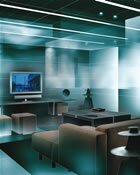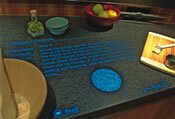Inflight Magazine of Brussels Airlines
Welcome to the Inflight Magazine of Brussels Airlines
Tomorrow’s home today
 From cables to wireless, from Bakelite to flat-screen, technology in the home has come a long way. But, as Margaret Carragher discovers, there’s quite a way to go yet
From cables to wireless, from Bakelite to flat-screen, technology in the home has come a long way. But, as Margaret Carragher discovers, there’s quite a way to go yet
Imagine a home that can alter the look of a room to match a person’s mood, that can ready itself for its owners by playing music, drawing the blinds and dimming the lights. How about a kitchen that knows to the last grain of salt what’s in the cupboards, can decipher food bar codes in nanoseconds, and can cook better than any celebrity chef – and with none of the temper tantrums, either. Imagine no more, for such a home exists.
Home to the future
Although it was first launched in 1994, the Microsoft Home (microsoft.com) is constantly evolving to reflect the latest in technological developments. Located at Microsoft’s US headquarters in Redmond, Seattle, it simulates environments such as the kitchen, family room, entertainment room and bedroom, employing a broad range of technology in each space to examine how software can improve people’s lives.
According to the director of Microsoft’s Consumer and Prototyping Strategy Team: “We see the Home as an organic, living space where we can bring our most innovative ideas to life.”
The Microsoft Home uses a biometric palm reader to identify individuals and only allows residents to enter. At the same time the Home readies itself for its occupants by playing music, dimming or intensifying the lights and drawing the blinds.
As the owner chills out in the lounge, things are hotting up in the kitchen. Because the Home already knows what’s in the cupboards, it can display a choice of recipes on the countertop that use the ingredients already in stock. To make things even easier, foods labelled with bar codes can be read by the microwave oven and cooked automatically – it makes dining out so last season, darling.
And ladies, wouldn’t we all like to have the mirror in the teenager’s bedroom which uses gesture recognition technology to help ditherers decide what to wear. It even knows what’s at the dry cleaners. Time to dispense with the personal valet, then.
Technology for the next generation
 But if Microsoft has the Home, Bang & Olufsen (bang-olufsen.com) has the key. A Danish company renowned for its audio, video and multimedia products, Bang & Olufsen invites customers to imagine their living space as the best cinema in the world, accessible with their own personalised entertainment key, the Beo5 remote control. As unique as a house key, this device controls just the products you have and nothing more. So there’s always an answer to the vexed question: “And what does this button do?”
But if Microsoft has the Home, Bang & Olufsen (bang-olufsen.com) has the key. A Danish company renowned for its audio, video and multimedia products, Bang & Olufsen invites customers to imagine their living space as the best cinema in the world, accessible with their own personalised entertainment key, the Beo5 remote control. As unique as a house key, this device controls just the products you have and nothing more. So there’s always an answer to the vexed question: “And what does this button do?”
Billed as “the ultimate home cinema experience”, the BeoLiving system features drop-down screens that only appear when you need them and pretty much every piece of integrated audio and video equipment you could want. You can even go the whole hog with full home automation, where all the commands are combined in a single button that dims the lights, draws the curtains and sets the speakers to surround sound. Who knows, maybe one day it will even pack the kids off to bed.
With space in today’s homes at a premium, Richard Brindley from the Royal Institute of British Architects’ predicts that homes of the future will have to be more adaptable. “The technology already exists to build houses with moveable walls to enable one space to accommodate a variety of functions,” he says. “And with the refinement of glass technology, it is possible to have glass that changes from clear to opaque at the flick of a switch, turning public spaces into private and vice versa.”
 Of the ubiquitous wall-mounted flat-screen TV, Brindley says: “This has the potential to double up as your front door intercom and be part of your décor, displaying your art collection or family photos.” However, he downplays the role of clunking robots in future home scenarios: “They’re more likely to be small and silent, rather than Jeeves-like humanoids brandishing feather dusters and cocktails.”
Of the ubiquitous wall-mounted flat-screen TV, Brindley says: “This has the potential to double up as your front door intercom and be part of your décor, displaying your art collection or family photos.” However, he downplays the role of clunking robots in future home scenarios: “They’re more likely to be small and silent, rather than Jeeves-like humanoids brandishing feather dusters and cocktails.”
In Vilvoorde, just outside Brussels, Living Tomorrow (livingtomorrow.be) is a permanent exhibition that demonstrates how tomorrow’s technology can integrate with people’s daily lives. Like its Microsoft cousin, the European smart home, entitled Tomorrow’s House, is regularly revamped to reflect the latest technological developments. Showcasing the work of top Belgian architects, designers and technology companies, the House is wired for remote control and features beds that can adapt to their occupants’ size and shape. It can even deter intruders by filling itself with clouds of artificial mist, thus reducing visibility and confounding would-be burglars. Looks like Fido’s out of a job.
Thinking outside the box
 Just over the border, in the Netherlands, developer Dura Vermeer (duravermeer. nl) has come up with a novel and practical solution to the contemporary concern of chronic land shortage and rising sea levels – houses that float. According to Dura Vermeer spokesperson Chris Zevenbergen: “We are trying to develop new types of buildings which are more sustainable and have no adverse impacts on the environment.”
Just over the border, in the Netherlands, developer Dura Vermeer (duravermeer. nl) has come up with a novel and practical solution to the contemporary concern of chronic land shortage and rising sea levels – houses that float. According to Dura Vermeer spokesperson Chris Zevenbergen: “We are trying to develop new types of buildings which are more sustainable and have no adverse impacts on the environment.”
With hollow concrete cubes fixed at their base to make them buoyant and vertical piles to anchor them to the land, the floating houses will take steadily rising water tables in their stride. They’ll also have the added advantage of rendering lawnmowers completely obsolete. So it’s snorkels at the ready then, folks.
 And then there’s talk of a ‘smart sofa’ being developed. A prototype that is sure to delight Homer Simpson devotees everywhere, the sofa has builtin microchip sensors which can not only identify its occupants, but can also anticipate their every possible need.
And then there’s talk of a ‘smart sofa’ being developed. A prototype that is sure to delight Homer Simpson devotees everywhere, the sofa has builtin microchip sensors which can not only identify its occupants, but can also anticipate their every possible need.
And if perchance those needs include a chilled beer? Not a problem for the boffins of Mitsubishi Electric Research Laboratories (merl.com) who have come up with a line of drinking glasses so smart they can practically order their own refills. Employing technology similar to that used in anti-theft tagging devices, a microchip tucked away in the base of the ‘intelligent’ glass monitors the volume of liquid contained therein and emits a signal when it falls to a level that might suggest the owner could be doing with more of the same.
Ah, but can it buy a round?
Or tip the barmaid? “Not as yet,” says a spokesperson, “but we’re working on it.”
FR La maison du futur, aujourd’hui
Imaginez une maison qui puisse transformer le style d’une pièce pour qu’elle reflète l’humeur d’une personne, et qui cuisine mieux que le plus célèbre des chefs. Non, vous ne rêvez pas – ce type de maison existe déjà
Bien que lancée en 1994, la Microsoft Home (microsoft.com) évolue constamment afin d’intégrer les dernières technologies. La Maison se prépare pour ses occupants en jouant de la musique, en réduisant ou en augmentant l’éclairage et en actionnant les persiennes. Un lecteur biométrique de contrôle d’accès identifie les individus par la morphologie de la main. La Maison affiche des recettes pour les ingrédients recensés dans les armoires ou pour les aliments qui disposent d’un code-barre et qui peuvent être réchauffés automatiquement dans le micro-onde. Un miroir dans la chambre à coucher utilise la technique de reconnaissance des mouvements du corps pour aider les habitants à choisir leurs vêtements du jour – le système sait même ce qui a été déposé au nettoyage à sec.
La société danoise Bang & Olufsen (bang-olufsen.com) a développé une commande à distance personnalisée Beo5 pour le système complet de divertissement. Le dispositif BeoLiving descend les écrans et met en route les équipements intégrés audio et vidéo. Un simple bouton réduit l’éclairage, ferme les tentures et allume le système de son surround à 360°.
À Vilvorde, près de Bruxelles, Living Tomorrow (livingtomorrow.be) expose une maison intelligente européenne. Parmi ses caractéristiques, on trouve des lits qui s’adaptent à la taille et aux formes de ses occupants, et des salles de bain aux robinets contrôlés par la voix. La Maison peut même arrêter les intrus en se remplissant d’un brouillard artificiel.
Aux Pays-Bas, Dura Vermeer a construit des maisons flottantes. Elles sont conçues sur une structure de base formée de cubes creux en ciment qui fonctionnent comme des bouées, et des piliers verticaux permettent de les ancrer sur terre. Ces constructions sont élaborées pour s’adapter à la montée du niveau des eaux.
NL Het huis van morgen, vandaag
Beeld je een huis in dat de inrichting van een kamer kan aanpassen aan het humeur van de bewoner. Een huis dat beter kan koken dan om het even welke chef-kok. Het is geen droom – zo’n huis bestaat echt
Het project werd al in 1994 gelanceerd, maar het ‘Microsoft Home’ (microsoft.com) evolueert voortdurend zodat het op elk moment de laatste nieuwe technologie in huis heeft. Het huis verwelkomt zijn bewoners met muziek, dimt het licht of doet de lampen helderder schijnen, en doet zelf de gordijnen dicht. Via een biometrische handlezer herkent het huis zijn inwoners of bezoekers en laat ze toe binnen te komen. Het huis stelt recepten voor op basis van de ingrediënten die het terugvindt in de keuken en de microgolfoven maakt automatisch voedsel klaar dat is voorzien van een barcode. Een spiegel in de slaapkamer is uitgerust met technologie om gebaren te interpreteren zodat hij twijfelaars kan helpen bij het kiezen van een outfit. De spiegel weet zelfs op elk moment welke kledij er naar de droogkuis is vertrokken.
Het Deens bedrijf Bang & Olufsen (bang-olufsen.com) verkoopt een gepersonaliseerde Beo5 afstandsbediening voor een compleet home entertainment system. BeoLiving heeft uitschuifschermen en ingebouwde audio- en videoapparatuur. Met een druk op één knop worden de lichten gedimd, gaan de gordijnen dicht en worden de luidsprekers in surroundmodus gezet.
In Vilvoorde, dicht bij Brussel, staat een Europese versie van een ‘slim huis’: Living Tomorrow (livingtomorrow.be). De bedden daar passen zich automatisch aan in functie van de grootte en vorm van wie er in slaapt, en in de badkamer worden de kranen bediend via spraakherkenning. Het huis kan zelfs eigenhandig indringers afschrikken door overal kunstmatige mist te spuiten.
In Nederland heeft Dura Vermeer drijvende huizen gebouwd. Holle betonnen kubussen aan de basis zorgen voor drijfvermogen en verticale palen ankeren de huizen vast aan land. Zulke huizen hoeven zich niet druk te maken over een stijgende grondwaterspiegel.
Leave a Reply
